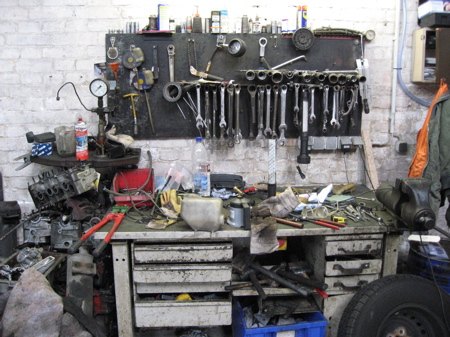Memoirs Of An Independent Auto Repair Shop Owner: World's Most Notorious Automotive Technologies, Bin Four
This is the fourth—and for the time being, final—submission in this Series, the format of which I described in the introductory remarks of Part One. The two egregious commissions covered in this article have less to do with technology, per se, and more to do with tactic. To re-emphasize an important ground rule I will not violate in this series, I’ll remind the reader that I won’t be pondering the reasons WHY these encroachments have been and continue to be committed against both technician and consumer alike. With BIN FOUR fully laden, it’s now time to UNLOAD!!
The Superseded-Parts Retrofit (aka: The Replacement Parts Assembly)
While it seems that manufacturers have reduced the frequency of this tactic—which involves major updates to critical hard parts—opting instead for computer system program updates, it (SPR) is still being foisted on the unsuspecting consumer and independent repair tech.
If the procedure happens to be covered by the manufacturer’s warranty, then they are the ones to take most of the consequential “hit”, and appropriately so.
The real problem comes into focus when the SPR must be performed out of warranty, and an independent repair shop is enlisted to do the dishonors. Let’s consider a case example, shall we.
Often, it seems, if the SPR doesn’t involve some plastic part (valve covers are common bogeys,) it will involve engine mounts. One of the worst cases I can remember was the XR4ti engine mount SPR.
Remember the XR4ti? As the Blue Oval Sierra in Europe it won critical acclaim, especially with Cosworth motivation under the bonnet. Apparently, however, the magic that accompanied this model in Europe died of scurvy on the journey across the Atlantic. They were a handful to keep serviceable and on the road stateside.
One came into my shop with a severed mount. It looked like a standard Euro-style “Rubber Biscuit” design, and I figured it was going to be no problem to change, as the accessibility to said biscuit was excellent. Unfortunately, I could not find any of my suppliers with the part in stock, or even a listing at all. No real problem, just have to get the part from the dealer for the usual 50%-plus additional cost over an aftermarket unit. The only problem with that strategy was that it didn’t take into consideration the possibility of the SPR factor applying here, which, much to my and my customer’s dismay, did!
Apparently, not wanting their customers to be subject to the “substandard” performance of a replacement mount identical to the one used originally, the redesigned replacement mount came with redesigned companion brackets as well. Of course, the cost for this SPR assembly, as I remember it, was at least three times the cost of what a typical biscuit mount would have cost by itself. Not wanting the opportunity to miss adding insult to injury, the labor cost to replace the whole contraption versus the solo mount was even more than that!
The truly most pathetic part of the whole experience was that other more expensive and intractable problems with these cars manifested themselves before any long-term benefit from the installation of this SPR could be realized! Truly egregious!
The “Unexplainable / Unexplained” Repair Procedure
I have often gotten a “kick” out of service manual Tech Writer’s trying to describe in words a repair procedure that involves a good quantity of “Chaos Theory”, i.e. a lot of transient variables related to the actual applied technique.
The most profound early experience I had—and I didn’t really get the “joke” until many years later—was when I read the description for installation of a crankshaft rear main “Rope” style seal. I checked more than one accredited manual and got about the same explanation. It sounded so complicated it really required something like a video presentation to accurately explain how to get the job done. I’d never seen any technician even come close to USING the technique described, or even AGREEING with the description in the manual, for that matter.
After some trial and error developing my own straightforward technique for installing these marginally performing “seals” I concluded that there wasn’t an instructional video accurately portraying the service manual’s description, because it was virtually IMPOSSIBLE to do so!
A more modern example of the Unexplainable Repair Procedure I find worth mentioning here is the service manual description of setting proper Timing Belt tension on the DOHC Diamond Star inline four cylinder engine. The difficulty stemmed from problems involving the belt stretching to the point of maxing-out the spring-loaded viscous-damped tensioner arrangement well before the belt was actually worn out. To address this problem, engineers incorporated a manually adjustable pre-tensioner indexing feature as part of the whole tensioner unit. It’s not really that hard to understand, but the service manual’s description for adjusting the arrangement is ridiculously more complicated than it has to be; and excellent results can be obtained by employing a common sense approach—which CAN actually be put in writing, AND be easily understood! I have not yet seen it in print in a service manual, though.
As far as the Unexplained Repair Procedure, I’d start by inviting a comparison of earlier factory service manuals—the ones actually printed by the manufacturer and sold over their dealer’s parts counter—to the modern factory service manuals often procured through online downloading.
It seems that the “Step-by-Step” description of any given repair procedure has itself been “overhauled” to a minimalist state. Wire-for-Wire electrical schematics, which were extremely helpful in many ways, are now a distant memory—replaced by vague “Flow Schematics”. Many other important procedural details have now been left out, and a tech can no longer rely on the factory service manual for truly complete and comprehensive information on how to repair a given vehicle system.
Apparently, some of this missing information is provided to dealer techs through schooling, but the irony here is that by the time the vehicles finally get old enough to be requiring such service, that information is no longer fresh in the minds of the techs!
Phil Coconis is the owner of a West Coast independent auto repair shop.
More by Phil Coconis
Latest Car Reviews
Read moreLatest Product Reviews
Read moreRecent Comments
- MaintenanceCosts Whenever the topic of the xB comes up…Me: "The style is fun. The combination of the box shape and the aggressive detailing is very JDM."Wife: "Those are ghetto."Me: "They're smaller than a Corolla outside and have the space of a RAV4 inside."Wife: "Those are ghetto."Me: "They're kind of fun to drive with a stick."Wife: "Those are ghetto."It's one of a few cars (including its fellow box, the Ford Flex) on which we will just never see eye to eye.
- Oberkanone The alternative is a more expensive SUV. Yes, it will be missed.
- Ajla I did like this one.
- Zerofoo No, I won't miss this Chevrolet Malibu. It's a completely forgettable car. Who in their right mind would choose this over a V8 powered charger at the rental counter? Even the V6 charger is a far better drive.
- Offbeat Oddity Nope, I won't miss it. I loved the 2008-2012 Malibu, but the subsequent generations couldn't hold a candle to it. I think the Impala was much more compelling at the end.


































Comments
Join the conversation
Find an on-line forum for your car. They all seem to have a " garage" section. You'll find in-depth info on how to do the needed repair. I've seen pictures included in some of the repairs. I've even printed out repair instructions and gave them to my mechanic. The print outs gave my mechanic these options: A think I'm a butt-head, B Throw them away, C Use them, he doesn't work on Miatas every day, D Slap me for being an insulting dimwit. Some may think A&D work well.
Setting the pinion depth and backlash on a rear differential is one of those things that is needlessly complicated. Most techs even shy away from these jobs because of it. Service manual way: -Requires dial indicator -Usually requires special service tool(s) $$$$$ -Measure using an, often, complex procedure -Order correct shims to put gears into spec and hope they are right vs. My way: -Re-use old shims -Apply prussian blue to gears and observe mesh pattern -If not in spec(2% probability), order extra shims in various dimensions to try, throw rest away.